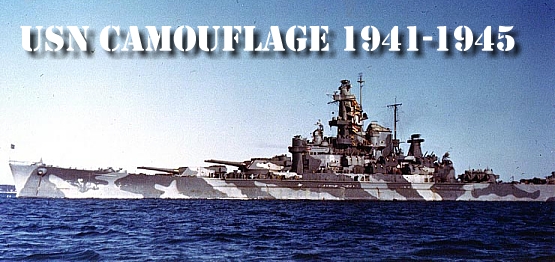
An online database of camouflage used by
United State Naval Warships during WWII
|
|
|
The
Development of Naval Camouflage 1914 - 1945 By
Alan Raven (Article reprinted courtesy of Plastic Ship Modeler Magazine issue #97/3) DARK
GREEN - FORMULA 759 Exact
color and tone unknown. It may be the color "Green IA" (1942 series),
or it could be the Dark Green of 5/84 - 4/5TMA. It should be noted that
"Green 1A" and "5/84 - 4/5TMA" are quite different in hue. MEDIUM
PINK Exact
color and tone unknown. No color sample or formula found. This color may have
been based upon the pink that was believed to have been worn by some British
corvettes in the 1941/42 period.* *
Not to be confused with Mountbatten Pink, a quite different color. MAUVE,
BLUE, GREEN Evidence
suggests that these colors could be Mountbatten Pink, Thayer Blue and Western
Approaches Green respectively. LIME
GREEN Exact
color and tone unknown. Known to be light in tone and used by APD's and landing
craft from mid 1942 into 1943. The color was usually used as the field or
background color, over which was painted streaks of dark green. UNION
CASTLE LAVENDER Used
only by the destroyer WINSLOW from very late 1941 until some time in early 1942.
The official name given by the Union Castle Company was "French Gray".
1944
TROPICAL GREEN PAINTS #1
GREEN (1944), 02 GREEN (1944), #3 GREEN (1944) Officially described as Outside
Green 1, 2, and 3, but usually referred to on camouflage sheets as simply #'s I,
2, and 3 Green. These colors should not be confused with the 1942 colors known
as Green 1A - 4A. #4
BROWN (1944) Officially
described as Outside Brown #4, but usually referred to on the camouflage sheets
as simply #4 Brown. In 1945 revised camouflage designs for Amphibious vessels,
#4 Brown became known as Outside Brown #4A. The color was exchanged. This should
not be confused with the 1942 color known as Brown 4A. 5-L
LIGHT GRAY (1941), 5-L LIGHT GRAY (1943), 037 LIGHT GRAY 5-L (1944) 5-L
(1941) should not be confused with 5-L (1943), the two colors being quite
different. 5-L (1943) was first used on Measures 23 and 31. 037 Light Gray 5-L
was a neutral gray (i.e. without hue) introduced in very late 1944. BLACK
Although
the color black was in use before 1941 (see table of colors), the designation
082 Black with the Munsell reference of N2.5/0 has 1941 as the earliest
documented date. 5-GTM
GREEN TINTING MEDIUM Although
not a camouflage paint in it's own right, this color has been included in the
table for the sake of completeness. #20
DECK GRAY (1919), #4 DECK GRAY 20 (1944) #20
Deck Gray (1919) should not be confused with 04 Deck Gray 20 (1944). Although
both were of neutral tone (i.e. a nice black and white only), #4 Deck Gray 20
(1944) was darker. ROBINS
EGG BLUE Exact
color and tone unknown. Known to be very light in tone. There is the possibility
that Robins Egg Blue is in fact Thayer Blue. #21
FLIGHT DECK STAIN (revised) 1942 #21
Flight Deck stain (1944), although different from the 1943 #21 stain, did not
have the word "revised" as part of the title on the official
camouflage sheets. The suffix was added by the author to distinguish between the
two stains. ELCO
GRAY Exact
color and tone unknown. Worn by several PT Boats upon arrival in the Pacific
Theater in 1942. "Elco Gray was a PT Boat crew term and the color may have
been "Ocean Gray". "Elco Gray was used by PT Boat squadrons 2 and
3 at the start of the Solomons campaign. LIGHT
GRAY GREEN Exact
color and tone unknown. Used from late 1942 by PT 61 and possibly other boats of
Squadron 3. |